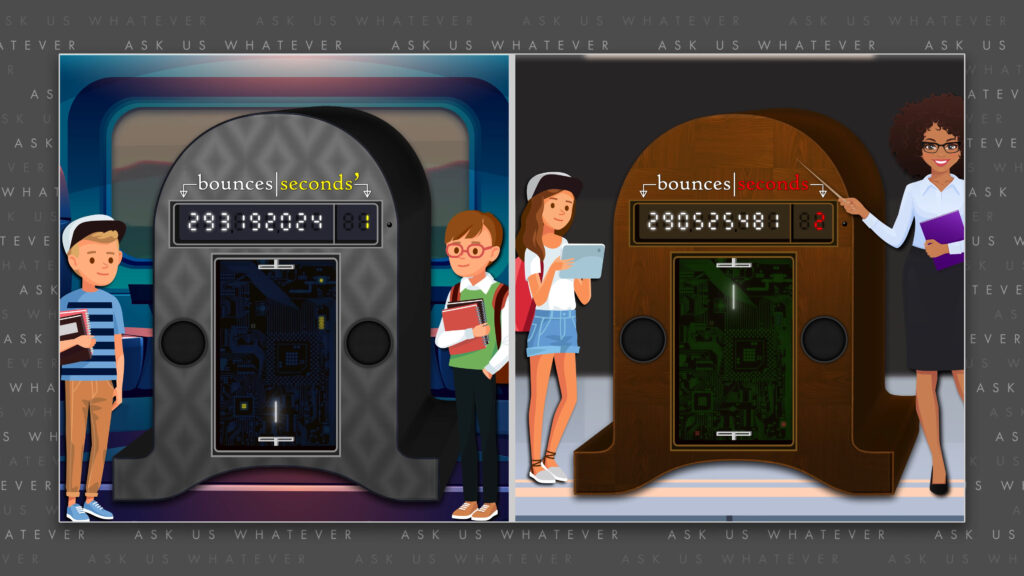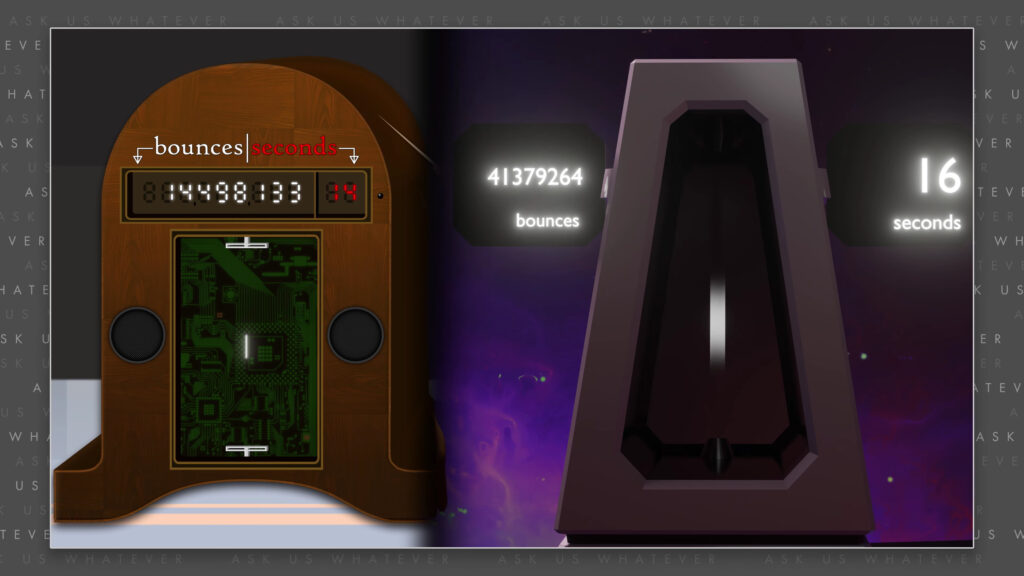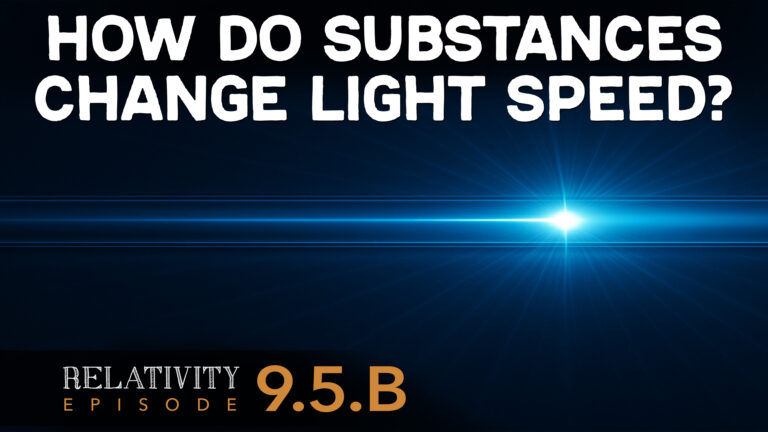Welcome to Ask Us Whatever. I’m your host, Joe Sorge.
This is Part 2 to our time dilation videos. In Part 1 we covered some of the formal mathematical background. Here, we are going to cover some practical implications.
Now let’s look at the differences between a light clock on a moving train compared to a light clock in the train station.
Let’s say that a light clock consists of two parallel mirrors separated by one meter. Let’s say that a physics teacher and her class are in a train station. She suggests to her students that they define a “second” as the time required for light to bounce about 300 million times from one mirror to the other. (By the way 300 million meters per second is just an approximation for the speed of light, but it makes the math easier.) The teacher asks the students to build a device that counts the bounces and makes an annoying, beeping sound each time 300 million bounces have occurred.

Let’s say another physics teacher on a train suggests the same thing to his students for a light clock on the train. If the two groups of students run their experiments together, the counting device in the station will beep more frequently than the counting device on the train, because the light on the train must travel a longer, diagonal path between bounces.

And since light is presumed to travel at the same speed in both inertial reference frames, the light clock in the station will rack up 300 million bounces sooner and more often than the light clock on the train. This means that the students on the train will define their unit of time, which we will call the second\(^{\prime} \), to have a longer duration than what students in the station call a second, because the light beam will have to travel a longer, diagonal distance between each bounce from mirror to mirror.
Let’s compare what happens when the observers in the station look at the light clock on the train instead of looking at their own light clock in the station. Since observers in the station and observers on the train are now both looking at the same light clock, light must strike the mirrors at the same instants for both sets of observers. (Ignoring any delays in the transmission of information). In the language of special relativity, these events are “frame independent”.

The observers on the train will still define one
But the observers in the station will see that their stationary light clock bounces more than 300 million times during the same interval. And so more than one stationary second will elapse during the interval needed for light to bounce 300 million times on the train.

What about Einstein’s postulate that the speed of light is the same for all observers? If two sets of observers use different clocks in their respective reference frames, won’t they compute different light speeds? Well, the outcome will depend on how they each define their unit of time.
So how was the “second” originally defined? It’s related to the length of the day.

The rotation of the Earth was divided into 24 hours, hours were divided into 60 minutes, and minutes were divided into 60 seconds. Light speed was then defined by measuring the distance that light travels in one Earth second.
Now I’m going to invoke the Copernican principle here, and ask us to view the Earth like a moving train. In other words, let’s assume that the Earth is not the center of the universe; instead let’s view the Earth and ourselves as moving through space.

And if we assume that we are moving relative to some imaginary center of the universe, then our Earth-seconds will be viewed as seconds\(^{\prime} \) by some master of the universe munching Cheetos in some cosmic train station.

So our light clocks will be like the light clocks built by the students on the train. Our clocks record approximately 300 million light bounces for every one of our
So what if we asked the master of the universe to put down the bag of Cheetos and build a light clock that also measures 300 million bounces in the cosmic train station?

That light clock would record cosmic seconds just like the clock built by the students in the train station. A cosmic second would be of shorter duration than an Earth

And since we have required the master of the universe to define a cosmic second as the time required for light to bounce 300 million times (I mean, who’s boss here?), the master would tell us that light traveled 300 million meters per cosmic second. You see, the constancy of the speed of light is all about how you define a local second. If you use circular logic to define a second as the time it takes light to travel 300 million meters, then of course light is going to travel at 300 million meters in every one of your seconds! It’s just a rigged number.
If another galaxy defined their seconds such that light traveled only 100 million meters per galaxy second, then we would not agree on the numerical value for light speed.
What really matter here is how fast light travels through space, not that everyone computes the same numerical value for light speed in their own reference frame. That’s simply an artifact of how we define our local units of time. So if the speed of light through space is the critical concept, then we need to define “space”. Which means that we need a coordinate system for space. Oops. That means that there’s a preferred reference frame against which the speed of light is measured? If so, it presents a fundamental challenge to Einstein’s special relativity, because what really matters is light speed relative to the preferred reference frame, not light speed relative to everyone’s local reference frame. The constancy of the latter is just an artifact, and that we will save for a future episode. 😁

You might be asking why any of this matters? What practical implication does it have? Well the clocks in GPS satellites are influenced by the speeds that the satellites orbit the Earth. These clocks are also influenced by a lower gravitational force, but that’s for a different video series. In terms of satellite speed, the clocks slow down due to the very effect we have discussed here. If we now treat the Earth as being stationary, (forget the guy eating Cheetos in the cosmic train station for a moment), then the satellite is like the train and we are like the people in the station. Before the satellite was launched, the on-board clock ticked at the same rate as clocks on the Earth’s surface. But once the satellite was put into orbit, its speed had a time-dilation effect on the clock within the satellite. And the effect is meaningful. In fact, the GPS systems in our phones and cars would be horribly inaccurate without adjusting satellite time for the effects of relativity. Like miles and kilometers inaccurate.

So there is a very meaningful application for relativity.
You know, one might ask why the clocks and watches that we bring into cars and trains and airplanes do not fall out of sync with clocks on the ground. Well, the speeds of cars, and trains, and airplanes are too slow to make any really noticeable difference. There is an effect, but the effect is so small that it changes clocks at a level of less than one part in 10 to the 13th – that’s 10 with 12 more zeros. So if you flew in an airplane for 10 hours, it would change your clock by less than one millionth of a second, not something that’s noticeable.
Another question is whether all clocks are affected by special relativity. This is debatable. I would argue no. Others are probably going to argue yes. It depends on whether the “ticker” is limited to moving at a fixed speed, like Einstein believed the light ticker in a light clock was limited. If a ticker is moving at a fixed speed in the y-direction, and its inertial reference frame begins to also move in the x-direction (like when a train moves), a light ticker must slow down.

But I don’t know if all tickers need to slow down. Would the motion in the x-direction simply add an x-component to its total velocity? In other words would the total ticker speed TS
\(TS_{total}=\sqrt{TS^{2}_y+TS^{2}_x} \)
increase when the x-component of the ticker speed is added to the y-component of the ticker speed? Obviously atomic clocks aboard GPS satellites behave the way that a light clock would behave. It makes sense, because the atoms of atomic clocks are subject to electromagnetic forces between the electrons and the nuclei, and these forces operate at light speed.
But I have a difficult time thinking that a pendulum or a clock that operates with a spring mechanism in the y- or z-direction would have to slow down in that direction to compensate for movement in the x-direction.

Such an effect has not been demonstrated for mechanical devices like pendulums or springs. Perhaps the effect would be too small to measure with modern day equipment, but there is good reason to doubt that all motion is limited by some universal speed limit, as we will demonstrate in later episodes.
So what about aging? Would we age more slowly when traveling at very high speeds? That’s the current belief. But frankly it depends on whether the motions involved in aging are limited to a fixed speed, like light speed. Many molecular motions are governed by electromagnetic forces, which operate at light speed. And so adding motion in a new direction would cause such electromagnetically-driven motion to slow down in the other dimensions. But whether this applies to all biological motion related to aging or not is debatable. If I had to guess, I would say that it does and that biological processes will slow down at high speeds. But that’s yet to be proven.
OK, that’s it for now. If you have any questions, write them in the comments section. I’m Joe Sorge. And thanks for watching.



